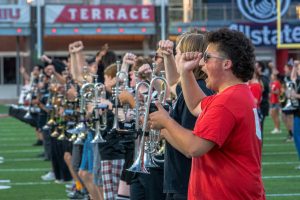Performers dance through the decades
February 21, 2003
The Joel Hall Dancers crossed into DeKalb on Thursday evening with performances portraying the evolution of music and dance styles through the years.
The program, dubbed “The Crossing,” began with a segment titled “Traditional African” and continued on, showing the melding of African-American musical style across the racial barrier. “Field Songs” reflected on the slavery days in the old American South, and a ragtime section depicted early 20th century styles. Blues and jazz styles also were represented before the dancers took part in the 1950s sockhop.
The dancing was comical at some points: During the sockhop, a “nerd” was avoiding a poodle-skirted girl, who tried to get him to dance. Their cat-and-mouse game around the stage sparked laughter from the crowd.
All the sections were bridged by a separate “crossing,” a pair of dancers, Camille Anderson and Leni Manaa-Hoppenworth, would take the stage, dancing to normal, every day sounds like crickets or car engines. Each crossing led the audience from one decade and style to the next.
The disco era took over the stage with the appearance of a gigantic purple platform shoe, complete with sparkles and lights. The shoe, well over 10 feet tall, was the background as the disco dancing broke out, complete with the stereotypical John Travolta-style dancing, as seen in “Saturday Night Fever.”
The dance party ended with house music, the new age party music with roots in Chicago. Dancers wore costumes styled from the ’80s, ’90s and today as they agilely flowed to the deep-based music.
Students attending this CAB Fine Arts production were pleasantly surprised.
“Honestly, I thought this was gonna be stupid,” said Chris Rzemieniecki, a freshman education major, who was bopping his head along with the music by the end of the first section.
Adrienne Robinson, a sophomore business major, thought along the same lines.
“I thought it was going to be boring at first,” Robinson said, saying the African dancing and small intermissions (the “crossings”) caught her attention.
Both students are in Phyllis Gooden’s Rhetoric and Composition (ENGL 104) class. Gooden, a Ph.D. candidate, assigned her students to the dance performance for a lesson in visual rhetoric.
“I thought they should have fun at the theater,” Gooden said, “and be able to see how rhetoric is involved in everyday lives.”
Two more students summed the audience’s thoughts up with their simple comments.
“The music is cool,” said Tim Mui, a freshman business major, while his neighbor, Robert Ramsey, a freshman undecided major, took a liking to the costumes and the dancing.
“This is a new experience for me,” Ramsey said of the performance without dialogue. “But it’s cool stuff, appealing to the eye.”courtesy photo
The Joel Hall Dancers express the evolution of music and dance throughout the year at their performance on Thursday.






